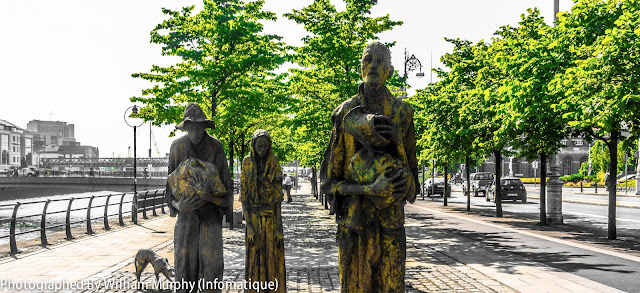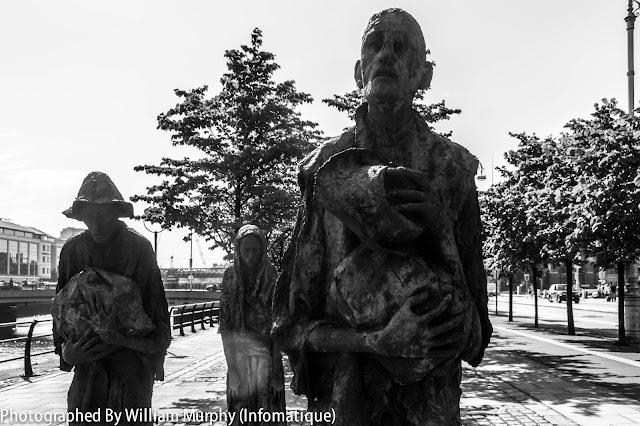Sunday, July 21, 2013
Famine (1997) on the Custom House Quay in Dublin
Public art is successful if it makes people stop, look and think and on that basis this work by Rowan Gillespie is a huge success.
Today when I visited there was a large number of young American tourists there and their guide was telling them about the "Irish Potato Famine". Americans refer to it as the "Irish Potato Famine" while we in Ireland to it as the "Famine" or the "Great famine"
Rowan Fergus Meredith Gillespie (born 1953) is an Irish bronze casting sculptor of international renown. Born in Dublin to Irish parents, Gillespie spent his formative years in Cyprus.
The Irish Famine and subsequent catastrophic migration has motivated two major works by Gillespie, and so it must be said that the portrayal of Famine, is a major theme of the artist's work. In several of his site specific pieces, such as Famine (1997) on the Custom House Quay in Dublin, his life-sized human figures are emaciated and haunting.
In June 2007, a series of statues by Gillespie was unveiled by President Mary McAleese on the quayside in Toronto's Ireland Park.
In Ireland, the Great Famine was a period of mass starvation, disease and emigration between 1845 and 1852.
During the Famine approximately 1 million people died and a million more emigrated from Ireland, causing the country's population to fall by between 20% and 25%. The cause of famine was a potato disease commonly known as potato blight. Although blight ravaged potato crops throughout Europe during the 1840s, the impact and human cost in Ireland — where one-third of the population was entirely dependent on the potato for food—was exacerbated by a host of political, social and economic factors which remain the subject of historical debate.
The famine was a watershed in the history of Ireland. Its effects permanently changed the island's demographic, political and cultural landscape. For both the native Irish and those in the resulting diaspora, the famine entered folk memoryand became a rallying point for various nationalist movements. Modern historians regard it as a dividing line in the Irish historical narrative, referring to the preceding period of Irish history as "pre-Famine".
Thursday, July 11, 2013
Public Art In Dublin: 'The Drummer' by Barry Flanagan
One of the Irish Museum of Modern Art's more recent acquisitions, 'The Drummer' by Barry Flanagan, was unveiled in the grounds at IMMA on Thursday 22 February 2001. The work - a 15ft-high bronze sculpture of a lively drumming hare - was donated to the Museum by the artist and is situated outside the main entrance.
'The Drummer' characterises Barry Flanagan's series of hare sculptures which have formed a large part of his work from the early 1980s to the present day. Flanagan's hares are spectacular in size and convey an extraordinary spontaneity and naturalness. There is nothing repetitive in his use of a single theme; each hare is extremely individualistic and dynamic. Many portray human attributes - dancing, playing instruments, engaging in sports and even using technical equipment. In addition to his emblematic hare sculptures, Flanagan's work also includes ceramic pieces, abstract sculptures, drawings in ink and pencil, water-colours and collages on paper in a wide range of subject matter including life studies, animals and abstract shapes.
Earlier this year (2013) I noticed the following in the Sunday Times: "A sculpture greeting visitors to the Irish Museum of Modern Art (Imma) for more than a decade was originally destined for Aras an Uachtarain but was turned down by Mary McAleese because the artist was not Irish, according to a new book."
Public Art: The Irish Museum of Modern Art was established by the Government of Ireland in 1990
The Irish Museum of Modern Art was established by the Government of Ireland in 1990 as Ireland’s first national institution for the presentation and collection of modern and contemporary art. The Museum was officially opened on 25 May 1991 by the, then Taoiseach Charles J Haughey. Since its opening the Museum has rapidly established itself as a significant and dynamic presence in the Irish and international arts arena. It is widely admired by its peers throughout the world for the range and relevance of its exhibitions, for its innovative use of its growing Collection, for its award-winning education and community programme and for its visitor-centred ethos and facilities.
The Irish Museum of Modern Art is housed in the Royal Hospital Kilmainham, the finest 17th-century building in Ireland. The Royal Hospital was founded in 1684 by James Butler, Duke of Ormonde and Viceroy to Charles II, as a home for retired soldiers and continued in that use for almost 250 years. The Royal Hospital is a striking location for displaying modern art. Modelled on Les Invalides in Paris, it is arranged around a courtyard and the interior has long corridors running along series of modest interlocking rooms. This has made for some interesting and visually exciting exhibits.
The original stables of the Royal Hospital have been restored, extended and converted into artists' studios and the museum runs an artist in residence programme.
Subscribe to:
Comments (Atom)















































